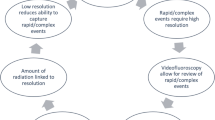Abstract
This study was designed to determine whether swallow rehabilitation outcomes were affected by the type of evaluation procedure utilized by the clinician. The two evaluation techniques compared were the bedside examination and videofluoroscopy (the modified barium swallow). Ten institutions participated in this study, enrolling a total of 103 partial laryngectomized patients, 21 in the bedside arm and 82 in the videofluoroscopy arm. Data on recovery of oral intake were collected weekly. All patients received an X-ray study of swallow at 3 months after the operation. Mean time to oral intake of food was significantly lower in patients assessed with bedside examination. Overall swallow measures of transit times and swallow efficiencies after 3 months revealed significantly better function in the videofluoroscopy group. Results are discussed in terms of the visibility of swallow physiology with the two assessment techniques, the accuracy of therapy planning with the bedside examination versus videofluoroscopy and the ability of head and neck cancer patients to tolerate some aspiration without developing aspiration pneumonia.
Similar content being viewed by others
References
Logemann JA:Evaluation and Treatment of Swallowing Disorders. San Diego: College Hill, 1983
Logemann JA:A Manual for Videofluoroscopic Evaluation of Swallowing, San Diego: College Hill, 1986
Dodds WJ, Logemann JA, Stewart T: Radiological assessment of abnormal oral and pharyngeal phases of swallowing.AJR 154:965–974, 1990
Dodds WJ, Stewart ET, Logemann JA: Physiology and radiology of the normal oral and pharyngeal phases of swallowing.AJR 154:953–963, 1990
Splaingard M, Hutchins B, Sulton D, Chaudhuro J: Aspiration in rehabilitation patients: videofluoroscopy vs. bedside clinical assessment.Arch Phys Med Rehabil 69:637–640, 1988
Schechter GL: Conservation surgery of the larynx. In Cummings C, Fredrickson J, Harker L, Krause C, Schuller D (eds.):Otolaryngology—Head and Neck Surgery, Vol. 3. St. Louis: Mosby, 1989, pp 2095–2115
Logemann JA, Kahrilas PJ: Relearning to swallow post CVA: application of maneuvers and indirect biofeedback. A case study.Neurology 40:1136–1138, 1990
Logemann JA, Kahrilas P, Kobara M, Vakil N: The benefit of head rotation on pharyngoesophageal dysphagia.Arch Phys Med Rehabil 70:767–771, 1989
Rosner B:Fundamentals of Biostatistics, 2nd ed. Boston, MA: Duxbury, 1986, pp 288, 326, 472
Lee ET:Statistical Methods for Survival Data Analysis. Belmont, CA: Lifetime Learning Publications, 1980, p 86
Breslow N: A generalized Kruskal-Wallis test for comparing k samples subject to unequal patterns of censorship.Biometrika 57:579–594, 1970
Jacob P, Kahrilas P, Logemann J, Shah V, Ha T: Upper esophageal sphincter opening and modulation during swallowing.Gastroenterology 97:1469–1478, 1989
Logemann JA: Airway closure mechanisms during swallow. Paper at ASHA convention, 1990
Author information
Authors and Affiliations
Additional information
This research was funded by NIH grant PO1 CA40007
Rights and permissions
About this article
Cite this article
Logemann, J.A., Pauloski, B.R., Rademaker, A. et al. Impact of the diagnostic procedure on outcome measures of swallowing rehabilitation in head and neck cancer patients. Dysphagia 7, 179–186 (1992). https://doi.org/10.1007/BF02493468
Issue Date:
DOI: https://doi.org/10.1007/BF02493468




